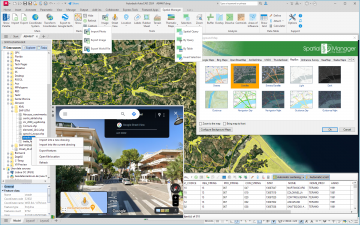Difference between revisions of "Spatial Manager™ for AutoCAD"
| Line 6: | Line 6: | ||
| − | The application use the same import engine and the same internal structure that [[Spatial Manager Desktop™ 2014 | Spatial Manager Desktop™]] | + | The application use the same import engine and the same internal structure that [[Spatial Manager Desktop™ 2014 | Spatial Manager Desktop™]], and, therefore, it has its own data Providers, easily configurable Coordinate Transformations and several process windows information |
| − | + | Spatial Manager™ for AutoCAD includes the following features: | |
| − | |||
*Fast display of graphic and alphanumeric spatial information coming from the most frequently used formats and data source types | *Fast display of graphic and alphanumeric spatial information coming from the most frequently used formats and data source types | ||
Revision as of 18:27, 11 January 2014
Spatial Manager™ for AutoCAD is an awesome AutoCAD plug-in designed for AutoCAD users who need to import and manage spatial data in a simple, fast and inexpensive way, and that includes a lot of possibilities not seen so far in AutoCAD. It comes to a lightweight application that runs inside AutoCAD and that allows the user to import geospatial data from spatial files, or spatial data servers, into AutoCAD drawings
Using a single panel in order to concentrate all the functionality of the application, its management is akin to that of other AutoCAD native panels. From this panel the user can set up its own data sources, launch the import processes for graphical objects and alphanumeric data and display them, because they are automatically converted to EEDs (Extended Entity Data) when imported
The application use the same import engine and the same internal structure that Spatial Manager Desktop™, and, therefore, it has its own data Providers, easily configurable Coordinate Transformations and several process windows information
Spatial Manager™ for AutoCAD includes the following features:
- Fast display of graphic and alphanumeric spatial information coming from the most frequently used formats and data source types
- Easily open spatial data files (SHP, GPX, SDF, KML, OSM, ASCII points, ...)
- Drag and drop spatial data to the maps
- Gain access to spatial database servers (SQL Server, PostGIS, WFS, ...), and ODBC connections
- Easy development of maps and easy to use styling methods
- Advanced systems for information access, such as shortcuts and user data sources that can store connection parameters or source configuration
- Systems for selecting and filtering spatial information
- Alphanumeric and spatial queries
- Editing of alphanumeric data and partially edit spatial features
- Find and replace data
- Management of the layers in the map and their storage
- Make new layers from selection or queries
- Split layers in new layers for thematic or data discrimination analysis
- Smart systems for map opening when modifying data sources
- Tools for importing and exporting between different formats or storage systems of spatial data
- Geometries transformation based on different coordinate systems in the import and export processes
- Easy methods to export information to be used in office applications or CAD
- Fast and intuitive printing of maps or selected features
- Definition and management of tasks for import or export processes
- Running tasks direct from the application or from the operating system Command window and chained tasks (batch processing)
To see a first preview of the application, please watch this video:
FAQs
Here you will find all the technical information available on the implementation as well as tutorials, additional data, etc.
- AutoCAD Commands
- Interface
- Providers
- Compatible AutoCAD applications
- Data sources
- Spatial files
- Databases
- Import
Links
Here you will find some useful links to other pages of Spatial Manager for AutoCAD™
